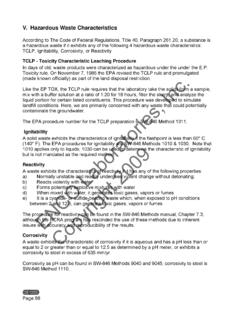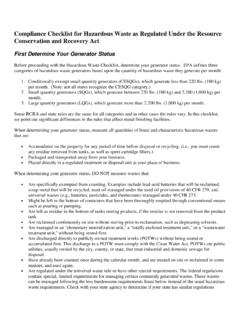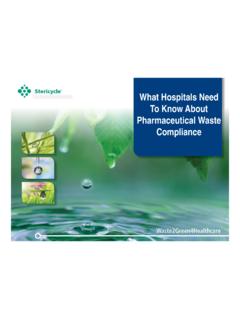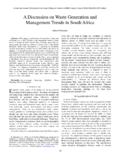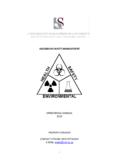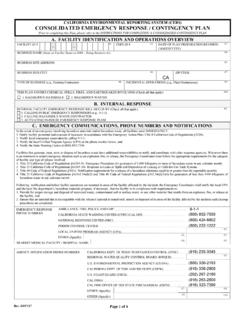Transcription of Secondary containment regulations overseen by the ...
1 It is a second barrier or an outer wall of a double enclosure which will contain any leak orspill from a storage container. Secondary containment helps protect the surface water,groundwater, and soils and reduce worker exposure to regulated substances. Thisenclosure is usually needed wherever regulated substances are being handled and storedin tanks, totes, drums, small pails, or other containment systems can be very simple or complex. The containment areamay be in a detached shed or building, an open area outdoors, an underground vault, in aseparate room, or in a dedicated portion of a larger space. It may include liquid tightstorage cabinets, berms, curbs, sills, sunken floors, special liners, drip pans or buckets,double-walled tanks, or other structures.
2 containment systems can be purchased as ready-made units or custom built on answer is probably yes if your business has any ofthe following regulated substances:l Flammable and combustible materialsl hazardous substancesl hazardous wastel Materials included on the federal CERCLA listl Materials included on the state Critical Materials Registerl Oil and other petroleum based products or wastel Salt (calcium chloride and sodium chloride)The various statutes and rulesdefine regulated substancesdifferently. Substances maybe regulated if they havebeen included on regulatorylists or by their flammability,corrosivity, reactivity, and/ortoxicity characteristics. Thesesubstances can be found iningredients, final products, if you are not required to have Secondary containment , you are encouraged to have it asa safety precaution.
3 The cost of installing and maintaining Secondary containment will be lessthan the cost associated with spill cleanup activities. Remember, the purpose of secondarycontainment is to provide environmental and worker to just meet anotherregulatory requirement!The regulatory requirements and the agencies which oversee those requirements vary withthe type and volume of material you have. Secondary containment is required by severalstate and federal regulations . In addition, you may have to meet local requirements oftenincorporated into zoning, building, fire protection, or other regulations . You will need toincorporate the most stringent requirements in your Secondary containment system ifyou have substances that are regulated by more than one agency or under differentregulations.
4 It is highly recommended that you contact all the involved agencies, and ifnecessary, schedule a joint meeting to discuss what would be best for your DEPARTMENT OF ENVIRONMENTAL QUALITYWASTE MANAGEMENT DIVISIONJohn Engler, Governor l Russell J. Harding, DirectorPO BOX Ml 48909 Secondary containment regulations overseen by the Department of Environmental Quality (DEQ) andthe regulating division include:lPart 5 Rules promulgated under Part 31 of 1994 PA 451, as amended. These regulations are underrevision - Surface Water Quality and waste Management DivisionslPart 111 of 1994 PA 451, as amended, and Rules; and federal Resource Conservation and Recovery Act(RCRA) 40 CFR Parts 260 to 299 - waste Management DivisionlPart 211 of 1994 PA 451, as amended, and Michigan Underground Storage Tank Rules.
5 These regulationsare under revision - Underground Storage Tank Divisionl1941 PA 207, as amended; and Michigan Storage and Handling of Flammable and Combustible Liquids(FL/CL) Rules- Underground Storage Tank Division NOTE: This program was transferred from theDepartment of State Police, Fire Marshal Division to DEQ on 10/ Secondary containment regulations and the regulating agencies include:l1974 PA 154, as amended; Part 75 Flammable and Combustible Liquid Rules; Rule 3220, open-surfacetanks ; along with federal safety standard 29 CFR , flammable and combustible liquids ; and 29 CFR , process safety management of highly hazardous chemicals - Department of Consumerand Industry Services, Bureau of Safety and Regulation (MIOSHA)lClean Water Act, under the Spill Prevention, Control, and Countermeasure (SPCC) requirements,40 CFR Part 112 - US Environmental Protection AgencyThe remainder of this publication applies to the regulations overseen by the waste Management citations are provided in brackets for those who want to refer to the specific on information from this document is not usable as a defense in any enforcement action orlitigation.
6 Additional information is provided in the Guide to Understanding Secondary ContainmentRequirements in Michigan. Call 800-662-9278 or contact your DEQ waste Management Division DistrictOffice to obtain a copy. Or contact the regulating agency to discuss your hazardous and UNIVERSAL waste regulations are found under Part 111 of 1994 PA451, as amended, hazardous waste rules, andRCRA. The specific hazardous waste regulationsyou must follow depend on if you are a:lGenerator and how much hazardouswaste you create in a month andaccumulate at your facility [40 CFR R ; orlTransporter [R and 94051; orlTreatment, storage, or disposal facility[R , 9617, and also depends on if you are accumulatinghazardous waste in containers or tanks, whatthose wastes are, and if those wastes are in aliquid or solid form [R and 9615, and 40 CFR , , , , It may be difficult to quickly detect anyleaks when using underground storage tanks toaccumulate hazardous waste .]]]]
7 If you havetanks; or are a transporter; or are a treatment,storage, or disposal facility, discuss yourrequirements with the waste ManagementDivision District Office quantity generators (LQG) accumulatingany amount of hazardous waste and smallquantity generators (SQG) accumulating over2,200 pounds of nonacute hazardous wastemust have Secondary containment for thefollowing:lContainers holding hazardous waste withfree liquidslHazardous waste with the codes of FO20,FO21, F022, F023, F026, or F027lAcute or severely toxic hazardous waste ifmore than pounds is storedThe containment must be able to hold 100% ofthe largest container or 10% of the volume of allthe containers in the system, whichever islarger. You also have to include enoughcapacity to hold any precipitation that mayaccumulate in the containment area.
8 If you havehazardous waste in a solid form and it is not oneof the above hazardous waste codes, theregulations do not specify a secondarycontainment volume. Conditionally exemptsmall quantity generators (CESQG) do not havespecific Secondary containment requirementsunless they accumulate more than 2,200 pounds2of nonacute hazardous waste or pounds ormore of acutely and severely toxic hazardouswaste. But CESQG hazardous waste must bemanaged to prevent any release into surface orgroundwater, or into drains or waste Generator CategoriesIn ONE month, the total amount of ALL nonacutehazardous waste is generated at the followingvolumes:LQG: more than 2,200 pounds [and/or poundsor more of acutely and severely toxic hazardouswaste is generated]SQG: 220 pounds to less than 2,200 never exceeds 13,200 : less than 220 pounds.
9 Accumulationnever exceeds 2,200 are also accumulation time generators are required toaccumulate wastes in an area that is designedand operated to remove any spilled or leakedwaste and accumulated precipitation in a timelymanner to prevent any overflow of the containers need to be elevated or otherwiseprotected from contact with any accumulatedliquid [40 CFR The accumulation areamust also be protected from weather, fire,physical damage, and vandals [R (1)(e)].In addition, large quantity generators arerequired to conduct weekly inspections of theaccumulation area and keep written records ofthose inspections for at least 3 years[R (l)]. They are also required to have a50 foot isolation distance from property lines forignitable and reactive hazardous waste storage[40 CFR are no specific Secondary containmentrequirements for universal waste being managedunder R unless there are signs ofleakage, spillage, or damage to the containerwhich could lead to leakage.]]
10 Those materialswould have to be put in another container whichcan prevent further release. All universal wastesneed to be managed in a manner that preventsreleases. Any release that does occur must beimmediately contained [40 CFR waste includes batteries, electriclamps, mercury switches, thermostats andthermometers, other devices containingelemental mercury, and some state regulations covering OIL,POLLUTING MATERIALS ON THE CRITICALMATERIALS REGISTER, AND SALT areoverseen by both the Surface Water QualityDivision and the waste Management regulations are found under Part 31 of 31994 PA 451, as amended, and the Spillage ofOil and Polluting Materials Part 5 Rules. Theseregulations apply to the following items at an oilstorage facility or on-land facility:lOil (means any kind or any form,including petroleum, gasoline, fuel oil,grease, sludge, oil refuse, and oil mixedwith waste ) in volumes greater than40,000 gallons unless the DEQdetermines a lesser volume for aparticular location due to environmentalrisk [R and R (2)].]










